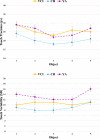Reaction Time Decomposition as a Tool to Study Subcortical Ischemic Vascular Cognitive Impairment
- PMID: 34632300
- PMCID: PMC8461746
- DOI: 10.3233/ADR-210029
Reaction Time Decomposition as a Tool to Study Subcortical Ischemic Vascular Cognitive Impairment
Abstract
Background: The study of reaction time (RT) and its intraindividual variability (IIV) in aging, cognitive impairment, and dementia typically fails to investigate the processing stages that contribute to an overall response. Applying "mental chronometry" techniques makes it possible to separately assess the role of processing components during environmental interaction.
Objective: To determine whether RT and IIV-decomposition techniques can shed light on the nature of underlying deficits in subcortical ischemic vascular cognitive impairment (VCI). Using a novel iPad task, we examined whether VCI deficits occur during both initiation and movement phases of a response, and whether they are equally reflected in both RT and IIV.
Methods: Touch cancellation RT and its IIV were measured in a group of younger adults (n = 22), cognitively healthy older adults (n = 21), and patients with VCI (n = 21) using an iPad task.
Results: Whereas cognitively healthy aging affected the speed (RT) of response initiation and movement but not its variability (IIV), VCI resulted in both slowed RT and increased IIV for both response phases. Furthermore, there were group differences with respect to response phase.
Conclusion: These results indicate that IIV can be more sensitive than absolute RT in separating VCI from normal aging. Furthermore, compared to cognitively healthy aging, VCI was characterized by significant deficits in planning/initiating action as well as performing movements. Such deficits have important implications for real life actions such as driving safety, employment, and falls risk.
Keywords: Aging; attention; cerebral small vessel disease; dementia; intra-individual variability; mental chronometry; reaction time; stimulus response/movement initiation & control; vascular cognitive impairment.
© 2021 – The authors. Published by IOS Press.
Conflict of interest statement
The authors have no conflict of interest to report.
Figures



Similar articles
-
Subcortical Ischemic Vascular Cognitive Impairment: Insights from Reaction Time Measures.J Alzheimers Dis. 2019;72(3):845-857. doi: 10.3233/JAD-190889. J Alzheimers Dis. 2019. PMID: 31594238 Free PMC article.
-
Relationship between reaction time variability on go/no go tasks and neuropsychological functioning in younger and older adults.J Clin Exp Neuropsychol. 2023 Nov;45(9):905-914. doi: 10.1080/13803395.2024.2319266. Epub 2024 Feb 18. J Clin Exp Neuropsychol. 2023. PMID: 38368621
-
Intra-individual reaction time variability in mild cognitive impairment and Alzheimer's disease: gender, processing load and speed factors.PLoS One. 2013 Jun 10;8(6):e65712. doi: 10.1371/journal.pone.0065712. Print 2013. PLoS One. 2013. PMID: 23762413 Free PMC article.
-
Biochemical markers in vascular cognitive impairment associated with subcortical small vessel disease - A consensus report.BMC Neurol. 2017 May 23;17(1):102. doi: 10.1186/s12883-017-0877-3. BMC Neurol. 2017. PMID: 28535786 Free PMC article. Review.
-
Neuropsychological assessment and cerebral vascular disease: the new standards.Rev Neurol (Paris). 2013 Oct;169(10):779-85. doi: 10.1016/j.neurol.2013.07.009. Epub 2013 Aug 30. Rev Neurol (Paris). 2013. PMID: 23999023 Review.
References
LinkOut - more resources
Full Text Sources

